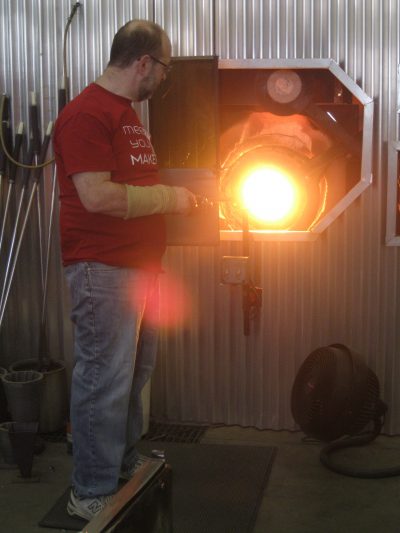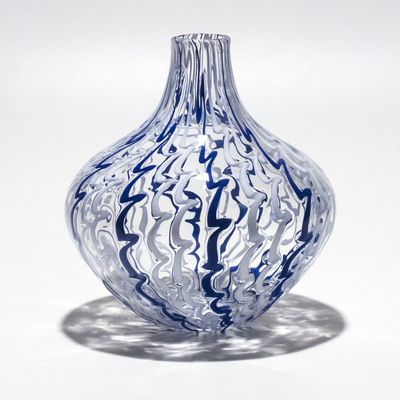Stowe, Snow, and Hot Glass

Glass on display at Little River Hotglass Studio. All photos are by the author, except where noted.
By Olivia J. Kiers
On a March morning in Vermont, snow covered the ground, reflecting the sunlight bearing down from a cloudless sky. The mountains around Stowe were filled with winter-sport lovers taking advantage of perfect conditions, yet these same conditions—cool and dry—were also perfect for a demanding indoor activity—glassblowing.
At mid-morning, I met Glenn Ziemke in his studio on Route 100 in Waterbury Center, just minutes from Stowe. Ziemke let me sit in the corner on his “best seat”—a well-used swivel chair—as he spoke about his career and creative process, all while crafting a vase. As he placed the molten glass in a reheating furnace known as the “glory hole” and blinding light spilled out of the opening, Ziemke shouted, “With people who have never seen glassblowing, you just see joy and astonishment on their faces, and that’s really rewarding for me as an artist, you know? Sometimes people applaud when they see a piece finished!”

Glenn Ziemke in his studio.
Ziemke Glass Blowing Studio opened 21 years ago in 1995. Before that, Ziemke made glass in Maine and New York, but his love of skiing and other outdoor activities directed his attention to Vermont. “I’m a big snow enthusiast,” he laughed. “I used to ski, and now I snowboard… When I saw this property on Route 100 and knew that Stowe was up the road, it just fell into place.”
Stowe was also the answer for fellow glassblower Michael Trimpol, who likewise relocated to the area in 1995. Originally based in Canada, Trimpol founded Little River Hotglass Studio in Stowe because he wanted to have a home, studio and retail location on the same property, in a resort area where sales would be high. He wanted to blow glass south of the Canadian border in order to gain better recognition in the U.S. market. And, he was familiar with the area—he had first worked with glass as a student who attended a private high school in Stowe, where a teacher introduced him to stained glass.

Micheal Trimpol in his studio.
“I just have an affinity for glass, and the process for stained glass was really natural to me,” Trimpol said as he explained his career decision. Yet, he quickly grew bored. “In retrospect, I much prefer working both three-dimensionally and dynamically. With stained glass, you measure it twice, you cut once, you match the pattern you’d come up with, and it’s not what viscerally satisfies me.” When he discovered glass blowing, Trimpol did not look back.
“Blowing glass is like an act of Zen,” he said, surrounded by orderly rows of perfume bottles, paper weights, and various vessels casting multicolored shadows across the white walls of his showroom. “It requires a really intense focus with part of your brain. Once you’ve learned how to do it, when you enter that state of awareness, it is really satisfying… It’s something you can pursue your whole life.”
Ziemke offered his own interpretation. “Glassblowing is almost a playful art in that it’s spontaneous creativity. Once you start a piece, you have to carry it through, or let it crash on the floor. You can’t stop, sip coffee, and look at it for a while. You just keep moving.” Ziemke also appreciates glassblowing’s dynamism because he came to it from another medium—pottery, in his case. “Making pottery is often a month-long process from the creation of the piece until it’s out on the shelf… Spontaneity is something I really appreciate, though I’ve been doing glassblowing for so long now that I’ve developed a line of signature items. These vases and platters”—he gestured through the transparent observation wall separating his studio from the shop—“with this marbling of color is something that I just keep playing with.”

Glasswork by Glenn Ziemke on display at Ziemke Glassblowing Studio.
“One of the things that’s a part of being a designer or a maker is to figure out how to make something, but make it different,” Trimpol said, showing me a new series of vessels featuring a surface of traditional cane lines—rods of color—twisted into non-traditional squiggles and loops. “Work should look like it belongs to somebody; it should have an underlying sensibility to it.”

Michael Trimpol, “Crazy Cane Navajo.” Photo courtesy Michael Trimpol.
Whether the work being produced is experimental or not, onlookers find themselves enchanted when they watch glassblowing live, and both of these Vermont studios offer just that. Ziemke’s business model is built around his observation wall, and he’s proud of how successful that approach has been. “People like buying an item they see made. I bring glassblowing before people so they can see it, and that gets them excited.”
While Trimpol stressed that, first and foremost, his practice focused on the finished product and his location on Moscow Road meant fewer drop-ins, even he wore a red T-shirt with the encouraging pun, “Meet Your Maker.” When two women stepped into the showroom from the cold, he smiled. “Do you want to see some glassblowing?” he asked. The answer, of course, was yes.
